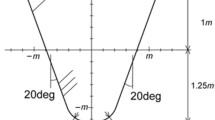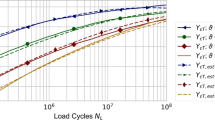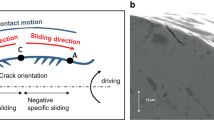Abstract
The present paper describes the load capacity of POM internal gears, which were evaluated from the results of running tests according to JIS B 1759. As a result, POM internal gears showed a higher load capacity than expected from the running tests performed against external ones. The tendency became marked, especially on internal gears mating with a relatively large number of teeth steel pinion. Two indexes were proposed to explain the higher load capacity, i.e., the ratio of contact ratio for loaded teeth to geometrical one and an integral value of the PV. The contact ratio plays a fundamental role in estimating a load on one tooth, and the PV value indicates the frictional work, i.e., the tooth temperature during meshing. At present, however, only these indexes are not enough to explain the higher load capacity. Furthermore, cracks due to tooth-bending stress were observed to examine the 60°-tangent method for determining the critical-section position of internal gears. The observation demonstrated that the 30°- or 45°-tangent could be more suitable for the determination.
Zusammenfassung
Dieser Bericht beschreibt die Tragfähigkeit von POM-Hohlrädern, die aus den Ergebnissen von Lauftests nach JIS B 1759 bewertet wurden. Im Ergebnis zeigten POM-Hohlräder eine höhere Tragfähigkeit als aus den durchgeführten Lauftests gegen Außenräder zu erwarten war. Die Tendenz wurde deutlich, insbesondere bei Hohlrädern, die mit relativ vielen Zähnen aus Stahlritzeln zusammenpassen. Zwei Indizes wurden vorgeschlagen, um die höhere Tragfähigkeit zu erklären, d. h. das Verhältnis von Überdeckung für belastete Zähne zu geometrischer Eins und einem Integralwert des PV. Bei der Abschätzung der Belastung eines Zahnes spielt die Überdeckung eine fundamentale Rolle, und der PV-Wert gibt die Reibungsarbeit an, also die Zahntemperatur während des Eingriffs. Derzeit reichen jedoch allein diese Indizes nicht aus, um die höhere Tragfähigkeit zu erklären. Darüber hinaus wurden Risse aufgrund von Zahnfußspannungen beobachtet, um die 60°-Tangentenmethode zur Bestimmung der Position des kritischen Abschnitts von Hohlrädern zu untersuchen. Die Beobachtung zeigte, dass die 30°- oder 45°-Tangente für die Bestimmung besser geeignet sein könnte.














Similar content being viewed by others
References
Höhn B‑R, Stahl K, Schudy J, Tobie T, Zornek B (2012) FZG rig-based testing of flank load-carrying capacity internal gears. In: GEARTECHNOLOGY 06.2012, pp 60–69
Sánchez MB, Pleguezuelos M, Pedrero JI (2016) Calculation of tooth bending strength and surface durability of internal spur gear drives. Mech Mach Theory 95:102–113
Singh A, Kahraman A, Ligata H (2008) Internal gear strains and load sharing in planetary transmissions: model and experiments. ASME J Mech Des. https://doi.org/10.1115/1.2890110
ISO 6336-3:2019, Calculation of load capacity of spur and helical gears Part 3: Calculation of tooth bending strength.
JIS B 1759:2019, Estimation of tooth bending strength of cylindrical plastic gears (in Japanese).
Moriwaki I, Fukushima T, Ueda A, Nakamura M (2010) Effect of rim thickness on fatigue breakage in plastic-gear teeth. J Japan Soc Precis Eng 76(2):201–206 (in Japanese)
Moriwaki I, Murakami T, Tatsuoka K, Iba D, Ueda A (2019) Load capacity of Polyacetal POM internal gears. J Japan Soc Precis Eng 85(6):591–596 (Issues of JIS B 1759 appeared in running tests for internal gears (in Japanese))
Hasl C, Liu H, Oster P, Tobie T, Stahl K (2017) Method for calculating the tooth root stress of plastic spur gears meshing with steel gears under consideration of deflection-induced load sharing. Mech Mach Theory 111:152–163
Amtec Inc. http://www.amtecinc.co.jp/new-catalogue/45.CT-FEM-Opera3.html
Moriwaki I, Watanabe K, Nishiwaki I, Yatani K, Yoshihara M, Ueda A (2005) Finite element analysis of gear tooth stress with tooth flank film elements, proceedings of VDI international conference on gears. VDI Ber 1904(1):39–53
Oda S, Mitachika K (1985) Practical formula for true root stress of internal spur gear tooth (in Japanese). Trans Japan Soc Mech Eng 51(470):2720–2725 (Series C)
Acknowledgements
The present study has been performed as a project supported by the JSPE technical committee on molded plastic gears. The authors extend sincere gratitude.
Author information
Authors and Affiliations
Corresponding author
Rights and permissions
About this article
Cite this article
Moriwaki, I., Tatsuoka, K., Kobayashi, K. et al. Load-Capacity Evaluation of Polyacetal (POM) internal gears according to JIS B 1759:2016 (Effect of number of teeth of pinion). Forsch Ingenieurwes 86, 535–544 (2022). https://doi.org/10.1007/s10010-021-00570-y
Received:
Accepted:
Published:
Issue Date:
DOI: https://doi.org/10.1007/s10010-021-00570-y




